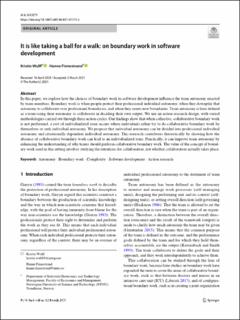| dc.contributor.author | Wulff, Kristin | |
| dc.contributor.author | Finnestrand, Hanne Gudrun | |
| dc.date.accessioned | 2021-09-15T13:23:01Z | |
| dc.date.available | 2021-09-15T13:23:01Z | |
| dc.date.created | 2021-03-15T15:02:10Z | |
| dc.date.issued | 2021 | |
| dc.identifier.citation | AI & Society: The Journal of Human-Centred Systems and Machine Intelligence. 2021, 1-14. | en_US |
| dc.identifier.issn | 0951-5666 | |
| dc.identifier.uri | https://hdl.handle.net/11250/2777449 | |
| dc.description.abstract | In this paper, we explore how the choices of boundary work in software development influence the team autonomy enacted by team members. Boundary work is when people protect their professional individual autonomy, when they downplay that autonomy to collaborate over professional boundaries, and when they create new boundaries. Team autonomy is here defined as a team using their autonomy to collaborate in deciding their own output. We use an action research design, with varied methodologies carried out through three action cycles. Our findings show that when collective, collaborative boundary work is not performed, a sort of individualized zone occurs where individuals either try to do collaborative boundary work by themselves or seek individual autonomy. We propose that individual autonomy can be divided into professional individual autonomy and situationally dependent individual autonomy. This research contributes theoretically by showing how the absence of collaborative boundary work can lead to an individualized zone. Practically, it can improve team autonomy by enhancing the understanding of why teams should perform collaborative boundary work. The value of the concept of boundary work used in this setting involves studying the intentions for collaboration, not whether collaboration actually takes place. | en_US |
| dc.language.iso | eng | en_US |
| dc.publisher | Springer | en_US |
| dc.rights | Navngivelse 4.0 Internasjonal | * |
| dc.rights.uri | http://creativecommons.org/licenses/by/4.0/deed.no | * |
| dc.title | It is like taking a ball for a walk: on boundary work in software development | en_US |
| dc.type | Journal article | en_US |
| dc.type | Peer reviewed | en_US |
| dc.description.version | publishedVersion | en_US |
| dc.source.pagenumber | 1-14 | en_US |
| dc.source.journal | AI & Society: The Journal of Human-Centred Systems and Machine Intelligence | en_US |
| dc.identifier.doi | 10.1007/s00146-021-01175-3 | |
| dc.identifier.cristin | 1898155 | |
| cristin.ispublished | true | |
| cristin.fulltext | original | |
| cristin.qualitycode | 1 | |

